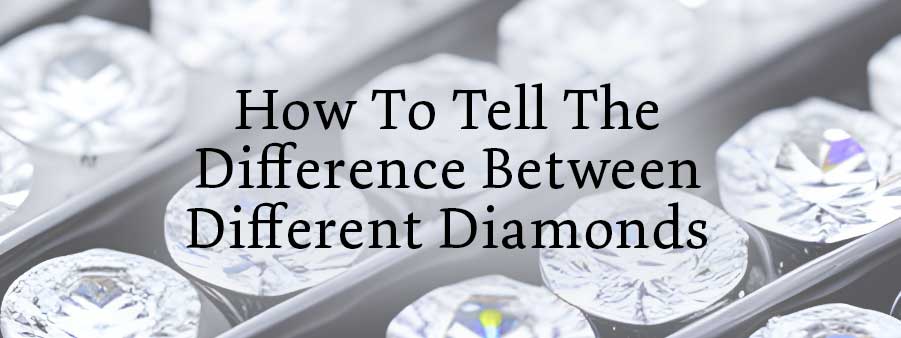
In this article, we bring you the latest information regarding various types of diamonds. As trusted, locally owned and operated diamond experts serving Boise, Meridian, Nampa, and other nearby localities in Idaho, Lee Read Diamonds wants to share our opinion as to what we see happening in the diamond market so you can make an informed decision when purchasing her diamond engagement ring.
Why it's so important to be able to tell grown diamonds from natural diamonds.
How to tell if a diamond is real or manufactured.
What synthetic diamonds look like on a diamond tester.
Do lab-grown diamonds work on a diamond tester?
The future lab-grown diamonds, natural diamonds, and diamond testing
Before we start, it's important to understand some of the terminology used to describe different kinds of diamonds. A Google search for "lab-grown diamonds wiki" in March of 2023 produced the following result.
"Synthetic diamond (also called laboratory-grown, laboratory-created, man-made, artisan created, or cultured diamond) is a diamond that is produced in a controlled technological process (in contrast to naturally formed diamond, which is created through geological processes and obtained by mining). Unlike diamond stimulants, (imitations of diamond, made of superficially-similar non-diamond materials), synthetic diamonds are composed of the same material as naturally formed diamonds – pure carbon crystallized in an isotropic 3D form – and share identical chemical and physical properties."
Humans have been fascinated by diamonds for thousands of years. They are unique and beautiful in their natural, uncut form, the hardest natural substance on Earth and they are very rare. This is why diamonds are so highly valued around the world. Because of their combination of unique traits, both raw diamond crystals and faceted diamonds have become a symbol of love between men and women. Women appreciate the fact that a man giving her a diamond is making a significant sacrifice, giving her something so rare and of such great value. The fact that diamonds are expensive is evidence of his personal sacrifice and represents his commitment to a life together. The perceived value of synthetic diamonds in jewelry is a different story. Lab Grown diamonds are the same chemically, physically, and optically but have little to no romantic or emotional symbolism. No one physically needs a diamond to survive, whether or not they are natural or manufactured. You can't eat them, they don't make you smarter and there are many other stones that sparkle and are just as beautiful as diamonds. So why are genuine diamonds so desirable?
Only natural diamonds are rare, billion-year-old miracles of Nature. That's why they're a symbol of the lasting commitment between two people. The value of diamonds is that they represent true love and are "the real thing". Man-made diamonds may be created of the same carbon but are like a copy of an expensive work of art. They look the same and are made of the same type of materials, but the artist and process are different. They are excellent copies, but a copy is worth a fraction of the price of the original.
The Pros Know: In the Spring of 2022, anyone can purchase a very nice quality, 1-carat cultured diamond from lightboxjewelry.com, for about $800. A similar quality natural diamond would sell for around $4,000 depending on where you purchased it. That's about 80% less than comparable genuine diamonds. If you want to know more about why this is so, please click here. The fact that lab diamonds sell for a fraction of the price of natural is the reason it is so important to be able to tell them apart.
Both have the same chemical, physical and optical properties. Nature grew her diamonds in molten magma over billions of years and man-made diamonds only take 2 to 4 weeks to produce in a machine using electricity. The result may be the same but the process is very different. Because of this difference, the uncut diamond crystal grows differently.
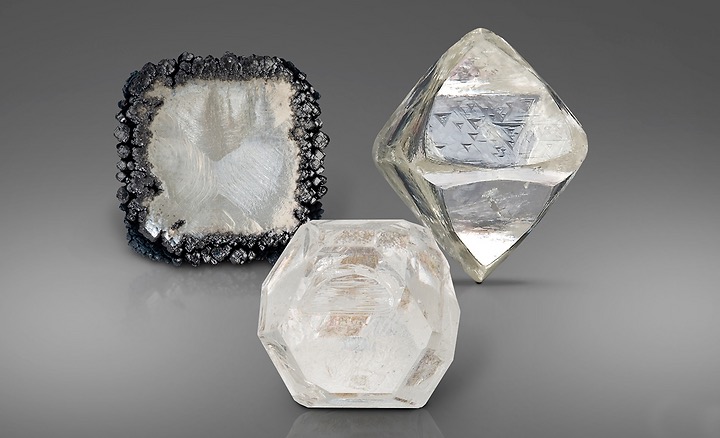
A CVD "lab-grown" diamond crystal, (on the right), HPHT lab-grown crystal, (centered), and a natural diamond crystal, (on the left). Photo Credit: GIA
Natural diamonds form in an 8-sided carbon crystal, known as an octahedral. This is due to the millions of years it takes to form in the extreme conditions below the surface of the Earth. Lab diamonds are made in a matter of weeks and form in either 6-sided crystals or square shapes depending on the equipment used to make them. This and other small differences in the crystalline structure, are the DNA of diamonds and are all that is needed to determine if a diamond is natural or lab-grown.
At Lee Read, we use The Yehuda V3 Sherlock Holmes lab-grown diamond tester. In fact, we own 3 of these machines. We use them every day at Lee Read Diamonds to test each item we receive from a supplier and at The Ring Doctors to check our Guest's jewelry for lab-grown diamonds, before and after it's repaired.
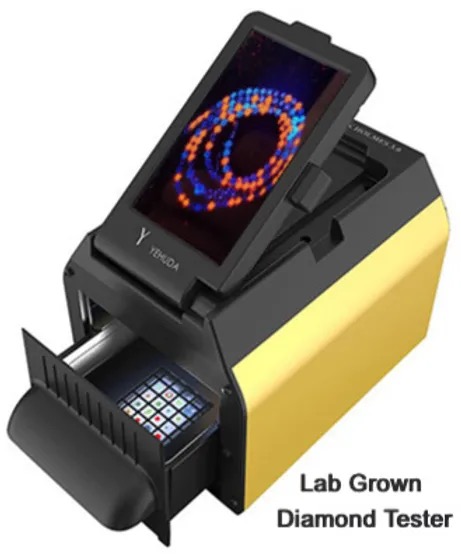
Diamonds on a Yehuda v3 Sherlock Holmes lab-grown diamond tester. The blue stones are natural the red are lab grown.
Here's an actual example of a test we conducted on a diamond necklace that was purchased online. The Certificate of Authenticity stated it had "diamonds" and the owner wanted to verify if their diamonds were real. It is easy to see that the stones in shades of blue are natural diamonds and the stones highlighted in red are lab grown. This test took about 30 seconds to perform.
The Pros know: Why would a jewelry manufacturing company mix expensive natural diamonds with cultured diamonds that cost up to 80% less? Because there is a lot of money to be made substituting cheap synthetic diamonds and selling them as the more expensive natural diamonds.
It's very possible the company that made this graduated diamond necklace paid for all-natural diamonds and was sold a mix of real and synthetic diamonds. If so, their supplier of loose diamonds would have made a big, illegal profit. We will never know for sure, but it's hard to believe a mix-up of this magnitude was an honest mistake. More than likely, someone purposely mixed these diamonds assuming no one would ever know. At Lee Read, it's our job to know and that is why we are the local diamond testing experts. This is why we own 3 of these diamond testing devices. We have been testing for treated and synthetic diamonds in our American Gem Society (AGS) accredited gem lab, using sophisticated testing equipment for 20 years. This is another reason why residents of Boise, Meridian, and Kuna recognize Lee Read as a Jeweler you can trust.
This is a great question and it's often answered incorrectly online. Here's why;
Before the introduction of lab-grown diamonds in 2015, the only diamond testers available were made to identify Cubic Zirconia (CZ's) and Moissanite as they were the most popular, simulated stones being sold as diamond look-a-likes. Almost all Jewelers have owned one of these testers in the past and they did a good job verifying these simulated diamonds.
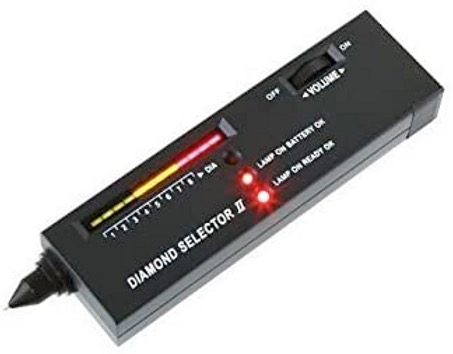
This is an example of a thermal diamond detector used to separate diamonds from CZ's and Moissanite.
These diamond detectors worked on the principle that diamonds are the best natural conductors of heat on the planet. The tip would get hot, then the Jeweler would touch the stone and if it was a diamond, it would conduct the heat away so fast it would test as a diamond. If the tip stayed hot it indicated the stone was CZ or Moissanite. They worked well for what they were designed to do. As we have already discussed, real and synthetic diamonds have the same chemical, physical and optical properties, which means both conduct heat the same way so this device is useless when testing for man-made vs genuine diamonds. Unfortunately, many early claims were made online that even diamond testers can tell difference. This will always be true if you are using a tester that was never designed for that purpose. Part of the problem is that much of the information you see online is out-of-date. While it was accurate to say diamond detectors couldn't test for lab-grown diamonds in 2015, lab-grown diamond testers are available to Jewelers today and they do a good job telling the difference between the two.
Any Jeweler that wants to know the difference can purchase a reliable lab-grown diamond tester for about $6,000. This may sound like a lot of money, but when your business is selling diamonds and you're representing your business as an expert, why wouldn't any reputable Jeweler invest in a lab-grown diamond tester simply to protect their reputation?
In the past, Jewelers helped their customers select meaningful romantic diamonds that could be handed down from one generation to the next. Today, the majority of Jewelers feel they have no choice but to sell cultured diamonds because they sell for so much less and have higher profit margins than natural diamonds. Sadly, they forget these copies have little or no symbolic value and that is what makes diamonds special in the first place.
Having a Jeweler you can trust is more important today than ever before. Here's one example of why;
In December of 2021, a national chain Jeweler, in the Meridian Idaho area, was asking $8,900 for a 2-carat lab-created diamond. Another jewelry store in the same market was advertising a 2-carat for less than $4,000 and a comparable 2-carat lab-grown diamond was available online, from a very reputable seller, for $1,600.
How could there be such a tremendous difference in these prices and which would you pick?
$8,900?
less than $4,000?
$1,600
We actually purchased the $1,600 diamond and analyzed it in our gem lab. It was of high quality and appeared to be everything it was represented to be. Our advice is if you are shopping for a man-made diamond, be very very careful because it is easy to pay far too much.
Consumers, not manufacturers, set the prices they are willing to pay for both. Obviously, men and women see the advantages of purchasing, giving, and wearing; real, genuine natural diamonds. Learn more here. In the consumer's mind, they are two very different things, one is the "real thing" and the other is "a man-made copy".
This chart (below) shows pricing trends we have seen as we have monitored both the natural and the lab market for diamonds. As experts, this is what we do and we provide this information to our Guests so they can make the best choice for themselves.
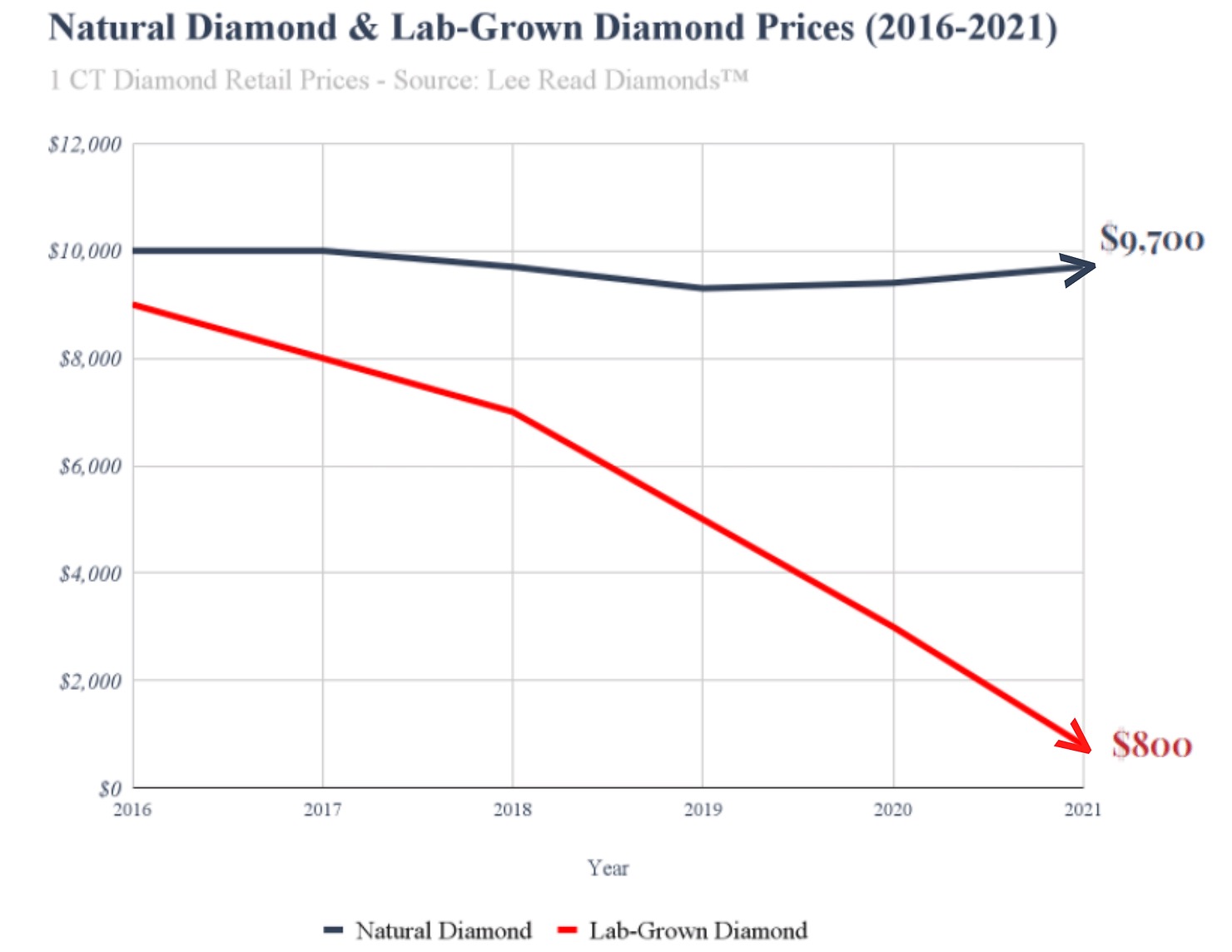
Natural diamond prices did dip during the pandemic but there were 2 price increases in 2021. The price of lab diamonds continues to fall year after year since they were first introduced in 2015.
For almost 60 years Lee Read has been providing accurate information related to diamonds, to our Guests so they can decide how to express their deepest feeling of love, admiration, and commitment. We understand we are not the right diamond store for everyone. We didn't sell CZs in the 1980s when they were proclaimed by the press as the diamond replacement of the future and we don't sell lab-grown diamonds today. There is nothing wrong with lab-grown (cultured) diamonds, but they do not have the same symbolism as real, natural diamonds. They're a great choice for a causal relationship or where someone just wants to have fun and show off the biggest bling in the room. But even then, be careful. In 2020 lightboxjewelry.com set the price to beat with a very nice 1-carat lab-grown diamond for $800. In 2o21, they introduced a very nice 2-carat lab-grown diamond for $1,600. Will there be a 3-carat lab-grown diamond for $2,400 this year? It's certainly possible, as man-made things always seem to come down in price when manufacturing processes improve and people figure out better ways to make them.
We hope you have enjoyed learning more about these different diamonds and please feel free to stop by, or contact us for more information. Our goal is to provide you with what you need to help you make the right decision. The most important factor is what you want her diamond engagement ring to say and represent. Only you know the answer to that question.